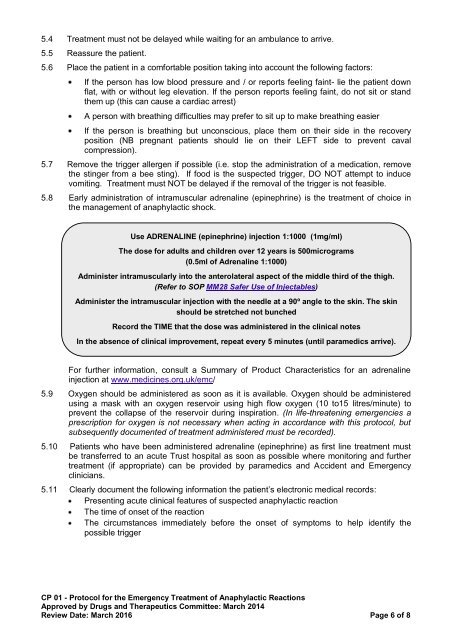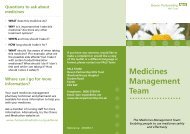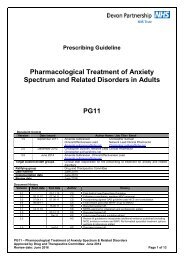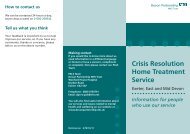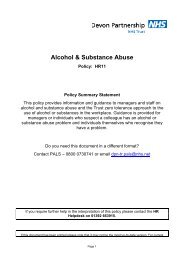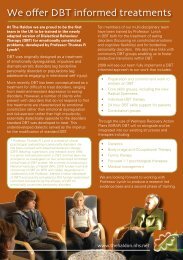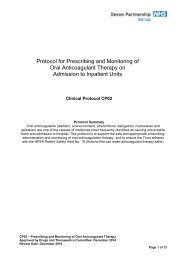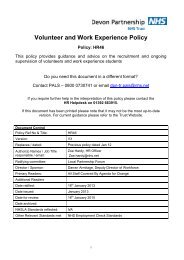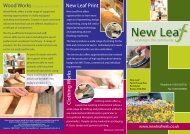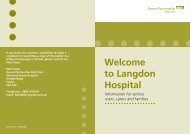CP01 Emergency Treatment of Anaphylactic Reactions - Devon ...
CP01 Emergency Treatment of Anaphylactic Reactions - Devon ...
CP01 Emergency Treatment of Anaphylactic Reactions - Devon ...
Create successful ePaper yourself
Turn your PDF publications into a flip-book with our unique Google optimized e-Paper software.
5.4 <strong>Treatment</strong> must not be delayed while waiting for an ambulance to arrive.<br />
5.5 Reassure the patient.<br />
5.6 Place the patient in a comfortable position taking into account the following factors:<br />
If the person has low blood pressure and / or reports feeling faint- lie the patient down<br />
flat, with or without leg elevation. If the person reports feeling faint, do not sit or stand<br />
them up (this can cause a cardiac arrest)<br />
A person with breathing difficulties may prefer to sit up to make breathing easier<br />
If the person is breathing but unconscious, place them on their side in the recovery<br />
position (NB pregnant patients should lie on their LEFT side to prevent caval<br />
compression).<br />
5.7 Remove the trigger allergen if possible (i.e. stop the administration <strong>of</strong> a medication, remove<br />
the stinger from a bee sting). If food is the suspected trigger, DO NOT attempt to induce<br />
vomiting. <strong>Treatment</strong> must NOT be delayed if the removal <strong>of</strong> the trigger is not feasible.<br />
5.8 Early administration <strong>of</strong> intramuscular adrenaline (epinephrine) is the treatment <strong>of</strong> choice in<br />
the management <strong>of</strong> anaphylactic shock.<br />
Use ADRENALINE (epinephrine) injection 1:1000 (1mg/ml)<br />
The dose for adults and children over 12 years is 500micrograms<br />
(0.5ml <strong>of</strong> Adrenaline 1:1000)<br />
Administer intramuscularly into the anterolateral aspect <strong>of</strong> the middle third <strong>of</strong> the thigh.<br />
(Refer to SOP MM28 Safer Use <strong>of</strong> Injectables)<br />
Administer the intramuscular injection with the needle at a 90º angle to the skin. The skin<br />
should be stretched not bunched<br />
Record the TIME that the dose was administered in the clinical notes<br />
In the absence <strong>of</strong> clinical improvement, repeat every 5 minutes (until paramedics arrive).<br />
For further information, consult a Summary <strong>of</strong> Product Characteristics for an adrenaline<br />
injection at www.medicines.org.uk/emc/<br />
5.9 Oxygen should be administered as soon as it is available. Oxygen should be administered<br />
using a mask with an oxygen reservoir using high flow oxygen (10 to15 litres/minute) to<br />
prevent the collapse <strong>of</strong> the reservoir during inspiration. (In life-threatening emergencies a<br />
prescription for oxygen is not necessary when acting in accordance with this protocol, but<br />
subsequently documented <strong>of</strong> treatment administered must be recorded).<br />
5.10 Patients who have been administered adrenaline (epinephrine) as first line treatment must<br />
be transferred to an acute Trust hospital as soon as possible where monitoring and further<br />
treatment (if appropriate) can be provided by paramedics and Accident and <strong>Emergency</strong><br />
clinicians.<br />
5.11 Clearly document the following information the patient’s electronic medical records:<br />
Presenting acute clinical features <strong>of</strong> suspected anaphylactic reaction<br />
The time <strong>of</strong> onset <strong>of</strong> the reaction<br />
The circumstances immediately before the onset <strong>of</strong> symptoms to help identify the<br />
possible trigger<br />
CP 01 - Protocol for the <strong>Emergency</strong> <strong>Treatment</strong> <strong>of</strong> <strong>Anaphylactic</strong> <strong>Reactions</strong><br />
Approved by Drugs and Therapeutics Committee: March 2014<br />
Review Date: March 2016 Page 6 <strong>of</strong> 8


